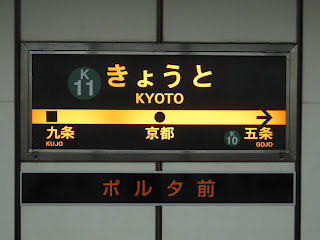1. Lowered passenger-side windows on trucks/lorries
In Japan as well as England, bicyclists risk getting squashed by trucks turning left. Back in the 1970s there was such an uproar about housewives getting killed while going shopping on their bikes that the government mandated that the windows on the passenger side of trucks had to be lowered so drivers could see the bicyclists alongside them. Here, 35 years later, Brits are catching on that lorry-caused bicyclist deaths are unacceptable; there are thus a few lowered windows around but they are not mandated...
2. Fully descriptive station signs
Note this subway sign has the name of the station as well as the previous and next stations, with an arrow pointing in the direction the train is going. Below in orange is the name of the major commercial area in front of the station. Note also the green circles; these are colour coded to the train line, the colour appearing on the train itself as well as on train-line maps, and here the stations are numbered, so even if you cannot read the station name, you know where your stop is if you can count.

I pity the poor tourists coming in for the Olympics (or any time) dealing with the London tube network. Not only are most of the trains unidentified on the sides of the trains as to which line it is, the lines are not identified in the digital signs showing arrivals. I don't know how many times I have been asked to differentiate the Circle, Hammersmith&City, and Metropolitan from the digital signs showing destinations. Why should anyone know or care where the train is going (unless one is interested in that stop) – what is vital is the name of the line and what the next stop is.
3. Men's toilets with baby-changing facilities
Back in the 1980s, at the height of the bubble, young Japanese men began deserting the Salaryman route to a career in droves. They valued family time more than 12-14 hour days in the office. These 'new men' have infiltrated Japanese society now to the extent that men's public toilets are beginning to appear with baby-changing facilities. Now, when do you think these will ever become popular in England??
4. Subway track shields
Japan has a high rate of suicide, with many choosing to throw themselves in front of a train. The subways are now being equipped with barriers on the platforms, so that people do not have access to the tracks very easily. London could use some of these, to keep people from falling, being pushed or jumping in front of tube trains. Note that the barrier doors open exactly in the same spots as the train doors, and arrows in front of them mark where people should queue to get on. Standing directly in front of the opening doors is therefore discouraged. London could use some of these, too.
 Ok, I admit they aren't a necessity, but these chain barriers are pretty neat. When a car comes out of the parking lot, it triggers the automatic dropping of the chain down to the ground so the car can exit; then the chain is raised again in this cool gate-post structure. Good thinking!
Ok, I admit they aren't a necessity, but these chain barriers are pretty neat. When a car comes out of the parking lot, it triggers the automatic dropping of the chain down to the ground so the car can exit; then the chain is raised again in this cool gate-post structure. Good thinking!







